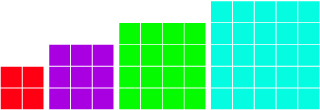Lesson 1
1. Lesson 1
1.2. Discover 2
Module 2: Logic and Geometry
Try This 2
Use the following information to answer Try This 2.

- Use a personal strategy to determine the number of squares in each of the following figures. For example, the 2 × 2 grid has 5 squares and the 5 × 5 grid contains 55 squares. You may find it helpful to organize your answers in a table or list like the one shown.

Grid Size 2 × 2 3 × 3 4 × 4 5 × 5 Number of Squares 5 55
personal strategy: an individual approach to a situation or problem using words or mathematical processes
Developing a personal strategy involves thinking about the situation or problem, planning how to solve the problem or situation, carrying out the plan, and, finally, evaluating the solution. The key is to be creative. Use diagrams, look for patterns, and don’t be afraid to try.
-
Once you have determined the number of squares in each grid, find a pattern that exists between the figure and the number of squares in each figure.

-
Identify how many squares would be in a 10 × 10 grid. Place a copy of your solution in your course folder. In your solution, include the following items:
- Complete a table or list identifying the number of squares in the figures. (Include a 10 × 10 grid in your answers.)
- Identify the pattern you think exists between the figure and number of squares in each figure using a statement.
- Explain the strategy used and why you chose that strategy. (In other words, did you change your strategy as the number of squares increased? Why or why not?)
- Complete a table or list identifying the number of squares in the figures. (Include a 10 × 10 grid in your answers.)
Share 2

Stockbyte/Thinkstock
With a partner, compare your results and discuss your personal strategy for identifying the number of squares in each figure. Summarize your discussions by answering the following questions.
- Explain your strategy to your partner. Did your partner use a different strategy?
-
Were your results the same for each figure and the overall pattern?
- If not, work together to determine the number of squares and the pattern. Revise your statement from Try This 2 to reflect your new pattern, if required.
- You may find it helpful to talk to other students as well about how they identified the pattern.
- If not, work together to determine the number of squares and the pattern. Revise your statement from Try This 2 to reflect your new pattern, if required.
-
Is there any part of your partner’s strategy that you could add or adapt to the approach you used to solve the puzzle?
Recall from the Course Introduction that you will be creating your own glossary. You have a couple of options. You may open and start a new Glossary Terms document now and add any new terms. Or, if you started a Glossary Terms document in Module 1 and saved it to your course folder, you may wish to continue adding new terms to this existing document and resave it to your course folder.